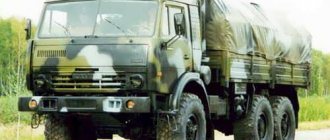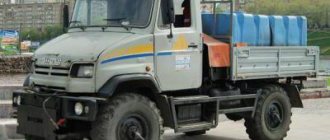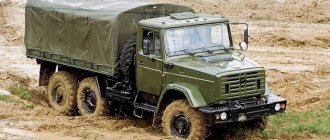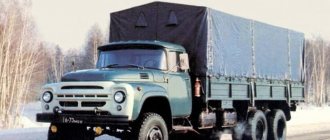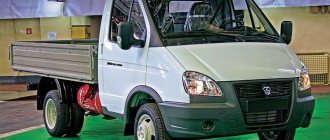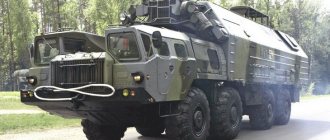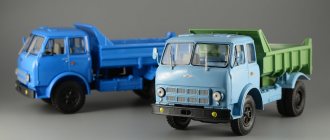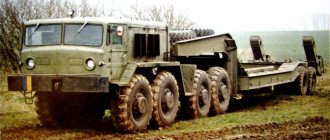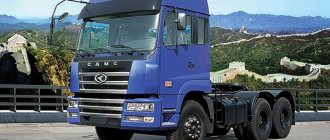4WD trucks are a bundle of muscle, with strong traction, performance and off-road capability. All-wheel drive trucks are used for work in quarries and other mining operations, and at large-scale construction sites (construction of nuclear power plants, dams and other large facilities). Also, all-wheel drive trucks are needed in the military sphere, where the range of equipment applications is very wide (from food delivery to direct military operations). All-wheel drive trucks are simply necessary when extinguishing fires, eliminating the consequences of natural disasters, clearing snow debris, delivering humanitarian aid to hard-to-reach areas, and so on. Obviously, this technique has some narrow application, and therefore is not mass-produced. All-wheel drive vehicles are produced using the dead-end assembly method, which significantly increases the cost of the final product.
Considering the peculiarities of Russian roads, one can imagine how many drivers dream of having an all-wheel drive truck for regular cargo transportation. But, unfortunately, all-wheel drive of a truck is a severe necessity that comes with a big price.
All-wheel drive KAMAZ 6522
KAMAZ and URAL - Russian giants
Currently, new products are in demand on the market. With greater productivity, efficiency and best quality. Understanding this, Russian equipment manufacturers are trying to take into account all the wishes of consumers. The most popular Russian-made all-wheel drive trucks are trucks based on the KAMAZ 6522 and URAL 6370 chassis.
It is worth understanding that having all-wheel drive is not all the qualities that an all-wheel drive truck should have. The KAMAZ 6522 all-wheel drive truck, or rather the 6x6 chassis, on the basis of which dump trucks, truck tractors and flatbed trucks are made, is popular among Russian consumers. The all-wheel drive truck has a load capacity of 17 and 22 tons (depending on design). The URAL 6370 all-wheel drive truck, in turn, is capable of hauling 22.6 tons. The carrying capacity of an all-wheel drive truck is not that important; traction characteristics and cross-country ability are much more important.
Presentation of the all-wheel drive dump truck URAL 6370
Also important for all-wheel drive trucks are characteristics such as differential locking and wheel inflation. You can't get away with a standard suspension in all-wheel drive trucks; the suspension travel must be increased, and the suspension itself must be further strengthened.
The traction of all-wheel drive vehicles is enhanced, and, of course, all-wheel drive trucks have a powerful engine to overcome all obstacles of swamps, deserts, rain-washed fields, forestry, steppes and other difficult areas. Thus, the URAL 6370 has a YaMZ 652 or YaMZ 6521 engine with a power of 410 or 362 hp. respectively. KAMAZ 6522 is capable of operating with a power of 235-320 hp.
It is worth immediately noting that these models of all-wheel drive trucks differ in size, KAMAZ is smaller in size. They also differ in their cabins. URAL received a cab with a berth, while KAMAZ is designed only for a driver and a passenger. All-wheel drive trucks are used where high speeds are not expected, so the designers enlarged the radiator to cool the engine. If the four-wheel drive truck will be used for driving on water, the cabin is additionally insulated to protect the engine.
Truck tractor based on KAMAZ 6522 chassis during operation
Experienced NATI all-wheel drive vehicles
The first stage of creating army vehicles with all-wheel drive was based on the experience of previous work of NATI and collaboration with the Moscow Automobile Plant, where, based on conventional ZIS-5 and ZIS-6 trucks, three trial 73-horsepower all-terrain vehicles K-1 and K-2. They were equipped with almost all original units, including engines and tires, and differed from production cars only in the installation of a two-speed transfer case and front drive and steering axles with imported constant velocity joints.
| Lifting tests of a four-ton K-1 vehicle on the territory of NATI. 1937 |
Despite powerful opposition, in 1937 the first and only model of the K-1 (6x6) appeared, created under the leadership of chief designer A. N. Ostrovtsev on the ZIS-6 chassis and becoming the first domestic three-axle all-wheel drive army truck. For the front drive and steered wheels, an axle with a split housing and a final drive from a semi-truck was developed. The curb weight of the car was 4.5 tons, the speed on the highway was 58 km/h. After testing, the military, accustomed to simpler technology, abandoned this vehicle, and its further development had to be frozen.
Front-wheel drive with drive axle and Rzeppa joints
Winter testing of the K-1 car at the NATI training ground
The second version of the K-2 (4x4), built in 1939 in two copies, was considered the first Soviet “heavy” two-axle four-wheel drive military truck. The prototypes K-2 and K-2bis differed in different main gears of the rear axles from the ZIS-5 and ZIS-6 - respectively, gear with modified gear ratios and worm.
Truck K-2 with front and bracelet anti-skid devices designed by NATI
The first experimental two-axle all-wheel drive truck NATI K-2 on the ZIS-5 chassis. 1939
The front drive axles of the K-2 base vehicle received split housings from the ZIS-5, main gears from the GAZ-MM and American Rzeppa hinges. The more complex version of the K-2bis had a narrowed front track, increased height and fastening the front wheel hubs with three bolts instead of six on the K-2 model. The curb weight of both vehicles was 480 kg higher than that of the serial ZIS-5, but fell within the limit of 3.6 tons.
Testing a K-2 vehicle with removable cross-country ability devices
All-terrain vehicle K-2 with front plate chains at the NATI training ground. December 1939
After testing, these trucks were transferred to the Moscow Automobile Plant, where they were modified and renamed ZIS-32. Meanwhile, NATI designers were already creating an all-wheel drive armored vehicle.
| The first Soviet all-wheel drive armored vehicle BA-NATI on a two-axle special chassis. 1939 |
In September 1939, the first Soviet light all-wheel drive armored vehicle BA-NATI (4×4) with rear gable wheels was assembled at the Vyksa DRO plant, created on its own initiative under the leadership of engineer N.I. Korotonoshko. In the NATI documentation, he had the index BA-8, then received the catchy name LB-NATI (“Lavrenty Beria”). Its basis was a shortened GAZ-MM chassis with a Dodge engine of 72 horsepower and a new transfer case. The rear axle was borrowed from GAZ-AAA, the cardan shafts were taken from the ZIS-101, and the front drive axle with Rzeppa hinges was taken from the GAZ-61 passenger car. The welded hull was equipped with a turret with twin machine guns.
Turret armored car BA-NATI (LB-NATI) with a 72-horsepower engine and three machine guns
All-wheel drive combat vehicle with front drive axle and Rzeppa joints
According to test results, the LB-NATI provided high cross-country ability, but turned out to be too heavy (4.6 tons), and at high speed the bullet-resistant tires quickly collapsed. It was recommended for modification using the more advanced GAZ-62 chassis, on which a couple of years later the new all-wheel drive LB-62 armored car was born.
Design Features
Fuel tanks are enlarged or several of them are installed, because the equipment is used where the driver can wait several hours to get to the nearest gas station. Particular attention in all-wheel drive KAMAZ and URAL is paid to ground clearance, ground clearance, wheelbase width and track width. Off-road is the absence of a straight horizontal surface for movement. Therefore, the corners of the overhangs must be cut off so that the cabin does not “bury itself” in the ground when descending from the mountain.
Both trucks have a reinforced frame structure and a 16-speed manual transmission. Both have good indicators in strength and cross-country ability. True, KAMAZ has a small cab overhang angle, which cannot be said about the Urals. The machines have similar characteristics. Also, the creators of URALs and KAMAZs try to equip their trucks with products from leading manufacturers of automotive components (brakes, fuel system, etc.).
Even with a quick look at the characteristics, it becomes clear that an all-wheel drive giant (such cars are rarely made with a short wheelbase) is not suitable for everyone, or rather, only for those who really need all the power and traction characteristics of a truck.
URAL 6370, all-wheel drive dump truck
Belated helplessness: experienced ZIS all-wheel drive military trucks
In Moscow, the main obstacle to the rapid implementation of promising vehicles was the “mighty scientific colossus” NATI (Scientific Automotive and Tractor Institute), where pundits spent a long time and tediously settling disputes between supporters of outdated half-track vehicles and fundamentally new all-wheel drive vehicles, work on which was sometimes carried out illegally.
| The first Soviet three-axle all-terrain truck NATI K-1 on the ZIS-6 chassis. 1937 |
Experienced NATI all-wheel drive vehicles
The first stage of creating army vehicles with all-wheel drive was based on the experience of previous work of NATI and collaboration with the Moscow Automobile Plant, where, based on conventional ZIS-5 and ZIS-6 trucks, three trial 73-horsepower all-terrain vehicles K-1 and K-2. They were equipped with almost all original units, including engines and tires, and differed from production cars only in the installation of a two-speed transfer case and front drive and steering axles with imported constant velocity joints.
| Lifting tests of a four-ton K-1 vehicle on the territory of NATI. 1937 |
Despite powerful opposition, in 1937 the first and only model of the K-1 (6x6) appeared, created under the leadership of chief designer A. N. Ostrovtsev on the ZIS-6 chassis and becoming the first domestic three-axle all-wheel drive army truck. For the front drive and steered wheels, an axle with a split housing and a final drive from a semi-truck was developed. The curb weight of the car was 4.5 tons, the speed on the highway was 58 km/h. After testing, the military, accustomed to simpler technology, abandoned this vehicle, and its further development had to be frozen.
| Front-wheel drive with drive axle and Rzeppa joints | Winter testing of the K-1 car at the NATI training ground |
The second version of the K-2 (4x4), built in 1939 in two copies, was considered the first Soviet “heavy” two-axle four-wheel drive military truck. The prototypes K-2 and K-2bis differed in different main gears of the rear axles from the ZIS-5 and ZIS-6 - respectively, gear with modified gear ratios and worm.
| The first experimental two-axle all-wheel drive truck NATI K-2 on the ZIS-5 chassis. 1939 |
| Truck K-2 with front and bracelet anti-skid devices designed by NATI |
The front drive axles of the K-2 base vehicle received split housings from the ZIS-5, main gears from the GAZ-MM and American Rzeppa hinges. The more complex version of the K-2bis had a narrowed front track, increased height and fastening the front wheel hubs with three bolts instead of six on the K-2 model. The curb weight of both vehicles was 480 kg higher than that of the serial ZIS-5, but fell within the limit of 3.6 tons.
| Testing a K-2 vehicle with removable cross-country ability devices |
| All-terrain vehicle K-2 with front plate chains at the NATI training ground. December 1939 |
After testing, these trucks were transferred to the Moscow Automobile Plant, where they were modified and renamed ZIS-32. Meanwhile, NATI designers were already creating an all-wheel drive armored vehicle.
| The first Soviet all-wheel drive armored vehicle BA-NATI on a two-axle special chassis. 1939 |
In September 1939, the first Soviet light all-wheel drive armored vehicle BA-NATI (4×4) with rear gable wheels was assembled at the Vyksa DRO plant, created on its own initiative under the leadership of engineer N.I. Korotonoshko. In the NATI documentation, he had the index BA-8, then received the catchy name LB-NATI (“Lavrenty Beria”). Its basis was a shortened GAZ-MM chassis with a Dodge engine of 72 horsepower and a new transfer case. The rear axle was borrowed from GAZ-AAA, the cardan shafts were taken from the ZIS-101, and the front drive axle with Rzeppa hinges was taken from the GAZ-61 passenger car. The welded hull was equipped with a turret with twin machine guns.
| Turret armored car BA-NATI (LB-NATI) with a 72-horsepower engine and three machine guns |
| All-wheel drive combat vehicle with front drive axle and Rzeppa joints |
According to test results, the LB-NATI provided high cross-country ability, but turned out to be too heavy (4.6 tons), and at high speed the bullet-resistant tires quickly collapsed. It was recommended for modification using the more advanced GAZ-62 chassis, on which a couple of years later the new all-wheel drive LB-62 armored car was born.
ZIS-32 - a unique pre-war cargo all-terrain vehicle
The army 2.5-ton ZIS-32 (4x4) was considered the only Soviet pre-war serially produced all-wheel drive truck. It was developed under the leadership of the leading designer of all-terrain vehicles and the head of the special department B. M. Fitterman. The basis of the vehicle was an experimental version of the NATI K-2, which had to be modernized and unified when put into production. Fundamental decisions included the vague hope of purchasing machine tools, production technologies and mastering our own production of Rzeppa hinges in the USA.
In September 1940, the ZIS-32 . Its front-wheel drive used a solid rear axle with a gear final drive from a three-ton car and Rzeppa hinges. The design turned out to be massive and quite heavy, which led to an increase in the weight of the vehicle and a decrease in traction qualities.
| Modified ZIS-32 truck with a high-sided body and side boxes for spare parts |
The ZIS-32 was equipped with the usual 73-horsepower ZIS-5 engine (by order of the military - ZIS-16 with a power of 85–88 hp), a new “transfer case”, different bodies and wheels with original anti-skid means, additional blackout lights, towing hooks and rifle rack in the cockpit. Compared to the ZIS-5, the curb weight increased to 3.7 tons (by 600 kg), the maximum speed was 65 km/h.
After the modernization of the prototype NATI K-2bis with a narrow gauge and more advanced and expensive Spicer joints with needle bearings, an experimental truck ZIS-32S , which did not go into production. At the same time, “ordinary” vehicles with Rzeppa hinges were renamed ZIS-32R.
| Option ZIS-32S with a four-plank body and three-bolt front wheels. 1940 |
| Front view of a ZIS-32R truck with Rzeppa constant velocity joints | Front view of the ZIS-32S car with a narrowed front track and Spicer hinges |
Despite the weight, the first “completely Soviet” all-terrain vehicle ZIS-32 was recommended for mass production, which was planned to be launched in October 1940 and the following year to produce four thousand vehicles. According to the adjusted plan, the solution to this problem was postponed until August 1941, which would have made it possible to modify the machine and create a train of different designs.
| Pre-war ZIS-32 with a five-plank body and blackout headlights. 1941 |
| ZIS-32 with a low army body and small blackout lights. Summer 1941 |
Individual assembly of cars with different bodies and rear tool boxes began literally on the eve of the war and continued until the evacuation of the plant in October 1941. A total of 197 cars were assembled by hand, which cannot be considered a full-fledged mass production. At the front they were used mainly as artillery tractors and chassis for light guns.
| ZIS-32 vehicle with a 37-mm 61K anti-aircraft gun, assembled in two copies. July 1941 |
In the fall of 1940, the development of the NAMI K-1 trial model became two three-axle tractor-trailers ZIS-36 (6x6) on the chassis of the serial ZIS-6. The first car was equipped with an 85-horsepower engine from the ZIS-16 bus, the second with an experimental six-cylinder diesel engine D-7 with a power of 97.5 hp. Both options were equipped with a rear bogie with double main gears, and the front axle and transfer case were unified with the ZIS-32.
| Experimental all-wheel drive three-axle truck ZIS-36. 1940 |
After successful tests in the winter of 1940–1941, the ZIS-36 was recommended for production, but it was not possible to organize its production before the start of the war. In the spring, one chassis was sent to the Izhora plant for the installation of an armored hull, but the completion of this work was also prevented by the war. With the launch of the ZIS-42 half-track vehicle into production, continuation of work on the ZIS-36 became impractical.
| Winter tests of a three-axle ZIS-36 vehicle with an artillery front end. 1941 |
| Tractor vehicle ZIS-36 when towing a 122-mm howitzer M-30 model 1938 with a limber |
Experimental wartime developments
The war and the evacuation of the Moscow Automobile Plant confused plans to create a new generation of trucks to replace the legendary three-ton, but under the influence of the flow of foreign vehicles pouring into the country, work on the creation of promising post-war rear-wheel drive trucks ZIS-150 and the future army vehicle ZIS-151 (6x6) came to the forefront. .
Since the end of 1943, several “model samples” of ZIS-150 with units from the unfinished pre-war ZIS-15 family. The first trucks received a flat lattice radiator lining of their own design; subsequent trucks did not differ in appearance from their Lend-Lease twin, the International KR11. Their characteristic feature was blackout headlights, which predetermined the predominantly military use of these vehicles.
| The first militarized model of the ZIS-150 with blackout headlights. Late 1943 |
| The second prototype with the front facing typical for ZIS-150 trucks. Early 1944 |
In November 1944, on the initiative of the plant, on the basis of the first ZIS-150 prototype, an all-wheel drive military prototype ZIS-150P (4x4) with rear dual-slope wheels and a welded protective radiator grille and headlights was created, which was considered a development of the pre-war ZIS-24 project. It was equipped with an imported front axle, transfer case and herringbone lug tires. The package included a canopy over the cargo platform with benches, two fuel tanks and two spare wheels.
| Experienced all-wheel drive truck ZIS-150P with imported units. Autumn 1944 |
Compared to conventional trucks, the weight of the ZIS-150P increased by a whole ton, and the military lost interest in it. By that time, the prevailing direction in the Ministry of Defense was towards American-style three-axle army vehicles, epitomized by the all-wheel drive ZIS-151.
In the title photo - Demonstration of the experimental all-wheel drive truck NATI K-2 with various anti-skid devices
Only authentic illustrations are used in the article.
Who will we compete with?
URAL, of course, has extensive experience in the production of all-wheel drive trucks. It would be more correct to say that URAL has only recently been working with industrial equipment, since for a long time it was associated exclusively with the military sphere. In order to “catch up” with the URAL, which is experienced in cross-country ability, KAMAZ had to work hard and bring its products to a competitive level.
Both models compete with each other to take a place in their customers' fleets. Each manufacturer has both its fans and opponents. Some criticize it for its fragility, short service life of components and low level of comfort, while others, on the contrary, consider Russian all-wheel drive cars to be the best in terms of price-quality ratio. After all, we should not forget that Russian manufacturers have to compete with foreign manufacturers such as MAZ, KRAZ and IVECO.
But so far, KAMAZ and URAL have successfully managed to maintain leadership positions in sales and popularity of all-wheel drive vehicles in Russia. This suggests that all-wheel drive vehicles produced in the Russian Federation meet the needs of the modern market.
ZIS-32 - a unique pre-war cargo all-terrain vehicle
The army 2.5-ton ZIS-32 (4x4) was considered the only Soviet pre-war serially produced all-wheel drive truck. It was developed under the leadership of the leading designer of all-terrain vehicles and the head of the special department B. M. Fitterman. The basis of the vehicle was an experimental version of the NATI K-2, which had to be modernized and unified when put into production. Fundamental decisions included the vague hope of purchasing machine tools, production technologies and mastering our own production of Rzeppa hinges in the USA.
In September 1940, the ZIS-32 . Its front-wheel drive used a solid rear axle with a gear final drive from a three-ton car and Rzeppa hinges. The design turned out to be massive and quite heavy, which led to an increase in the weight of the vehicle and a decrease in traction qualities.
| Modified ZIS-32 truck with a high-sided body and side boxes for spare parts |
The ZIS-32 was equipped with the usual 73-horsepower ZIS-5 engine (by order of the military - ZIS-16 with a power of 85–88 hp), a new “transfer case”, different bodies and wheels with original anti-skid means, additional blackout lights, towing hooks and rifle rack in the cockpit. Compared to the ZIS-5, the curb weight increased to 3.7 tons (by 600 kg), the maximum speed was 65 km/h.
After the modernization of the prototype NATI K-2bis with a narrow gauge and more advanced and expensive Spicer joints with needle bearings, an experimental truck ZIS-32S , which did not go into production. At the same time, “ordinary” vehicles with Rzeppa hinges were renamed ZIS-32R.
Option ZIS-32S with a four-plank body and three-bolt front wheels. 1940
Front view of a ZIS-32R truck with Rzeppa constant velocity joints
Front view of the ZIS-32S car with a narrowed front track and Spicer hinges
Despite the weight, the first “completely Soviet” all-terrain vehicle ZIS-32 was recommended for mass production, which was planned to be launched in October 1940 and the following year to produce four thousand vehicles. According to the adjusted plan, the solution to this problem was postponed until August 1941, which would have made it possible to modify the machine and create a train of different designs.
Pre-war ZIS-32 with a five-plank body and blackout headlights. 1941
ZIS-32 with a low army body and small blackout lights. Summer 1941
Individual assembly of cars with different bodies and rear tool boxes began literally on the eve of the war and continued until the evacuation of the plant in October 1941. A total of 197 cars were assembled by hand, which cannot be considered a full-fledged mass production. At the front they were used mainly as artillery tractors and chassis for light guns.
| ZIS-32 vehicle with a 37-mm 61K anti-aircraft gun, assembled in two copies. July 1941 |
In the fall of 1940, the development of the NAMI K-1 trial model became two three-axle tractor-trailers ZIS-36 (6x6) on the chassis of the serial ZIS-6. The first car was equipped with an 85-horsepower engine from the ZIS-16 bus, the second with an experimental six-cylinder diesel engine D-7 with a power of 97.5 hp. Both options were equipped with a rear bogie with double main gears, and the front axle and transfer case were unified with the ZIS-32.
| Experimental all-wheel drive three-axle truck ZIS-36. 1940 |
After successful tests in the winter of 1940–1941, the ZIS-36 was recommended for production, but it was not possible to organize its production before the start of the war. In the spring, one chassis was sent to the Izhora plant for the installation of an armored hull, but the completion of this work was also prevented by the war. With the launch of the ZIS-42 half-track vehicle into production, continuation of work on the ZIS-36 became impractical.
Winter tests of a three-axle ZIS-36 vehicle with an artillery front end. 1941
Tractor vehicle ZIS-36 when towing a 122-mm howitzer M-30 model 1938 with a limber
